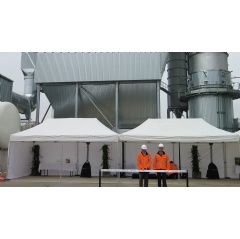GEA: tailor-made solutions for exhaust gas purification and energy recovery in the glass industry
GEA delivers state-of-the-art technology that helps customers reduce harmful emissions, especially in the glass manufacturing industry. The solutions make a significant contribution to meeting customers’ legal requirements and sustainability goals. Two orders in the single-digit Euro million range for EUROGLAS in Poland, a subsidiary of International Glas Trösch Holding AG and Guardian Luxguard in Luxembourg demonstrate the competitiveness of GEA solutions.
The float glass manufacturer EUROGLAS commissioned GEA to supply and install technologies for the desulphurization and denitrification of flue gases (DeSOx and DeNOx) as well as for the elimination of fine dust for two of its production lines at the Polish site in Ujazd. Each of these production lines consists of a DeSOx reactor, electrostatic precipitator, selective catalytic reactor and appropriate dosing and material handling systems. Commissioning is scheduled for this year.
GEA also developed and supplied an efficient solution for flue gas desulphurization and fine dust separation for Guardian Luxguard in Dudelange, Luxembourg. The Minister of the Environment of the Grand Duchy of Luxembourg officially handed over the plant. “The growth of today’s glass production takes place mainly in developing markets. Parallel to the furnace service life of around ten years, however, there are many opportunities to further reduce emissions. GEA has many good concepts in this area and their implementation is convincing,” says Andreas Palinski, Head of Emission Control at GEA. For example, there are basically several options available for exhaust gas purification in glass plants. The most common arrangements are based on electrostatic precipitator (ESP) dust separators, dry or semi-dry processes for sulfur removal and selective catalytic removal (SCR) of nitrogen oxides (NOx).
GEA is, however, taking an important step further in reducing emissions. In addition to some additional technologies such as ceramic candles for gas purification, GEA is able to offer advanced energy recovery systems to utilize the available heat in the flue gases.
About GEA
GEA is one of the largest suppliers for the food processing industry and a wide range of other industries that generated consolidated revenues of approximately EUR 4.6 billion in 2017. The international technology group focuses on process technology, components and sustainable energy solutions for sophisticated production processes in various end-user markets.The group generates around 70 percent of its revenue in the food and beverages sector that enjoys long-term sustainable growth. As of December 31, 2017, the company employed almost 18,000 people worldwide. GEA is a market and technology leader in its business areas. The company is listed on the German MDAX (G1A, WKN 660 200). In addition, GEA’s stock is included in the MSCI Global Sustainability Indexes.
( Press Release Image: https://photos.webwire.com/prmedia/7/230514/230514-1.jpg )
WebWireID230514
This news content was configured by WebWire editorial staff. Linking is permitted.
News Release Distribution and Press Release Distribution Services Provided by WebWire.
